Cancún
| Cancún | |
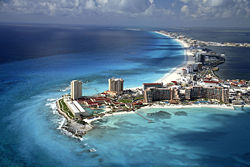 Caribbean Sea on left; Lagoon on right |
|
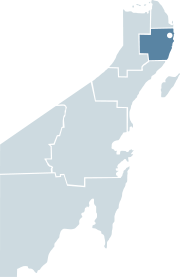 |
|
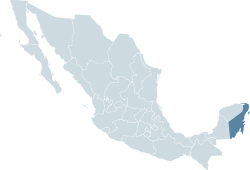 |
|
| Coordinates: | |
| Country | |
|---|---|
| State | |
| Municipality | |
| Foundation | April 20, 1970 |
| Government | |
| - Mayor | Gregorio Sánchez Martínez (PRD) |
| Highest elevation | 10 m (30 ft) |
| Lowest elevation | 0 m (0 ft) |
| Population (2005) | |
| - Total | 572,973 |
| - Demonym | Cancunense |
| Time zone | CST (UTC-6) |
| Postal code | 77500 |
| Area code(s) | 998 |
| Website: www.cancun.gob.mx | |
Cancún (pronounced as IPA: [kanˈkun]) is a coastal city in Mexico's easternmost state, Quintana Roo, on the Yucatán Peninsula. Cancun is located on the Yucatan Channel that separates Mexico from the island of Cuba in the Greater Antilles. Cancun's region is sometimes known as the Mexican Caribbean .
Cancun is the municipal seat of the Benito Juárez municipality and a world-renowned tourist resort. The city center is located on the mainland which connects over the Nichupté and Bojórquez lagoons to a narrow "7" shaped island where the modern beachfront hotels are located. The island of Isla Mujeres is a nearby island located off the coast and is accessible by boat from Puerto Juarez or Punta Sam.
The older section of the city, known as "El Centro" follows the original master plan, consists of neighborhoods called "supermanzanas" (superblocks) that are formed by the intersections of the boulevards and traffic circles (roundabouts). This area is characterized by winding streets with cul-de-sacs that tend to keep out the main flow of traffic, including market places such Xel Ha. They usually have one or more parks, green spaces, paseos (pedestrian walkways) and various national historical monuments.
Ave. Tulum is the main north-south artery (connecting downtown to the airport some 30 km (19 mi) to south). Tulum is bisected by Ave. Coba (pronounced Koh bah). East of Ave. Tulum, Coba becomes Ave. Kukulcan which serves as the primary road that runs through the long "7" shaped hotel zone. Ave. Tulum is terminated on the north side by Ave. Paseo José López Portillo which connects to the main highway to Chichen Itza and Merida. Another major north-south road is Ave. Bonampak which runs roughly parallel to Ave. Tulum. The main ferry to Isla Mujeres is located off Bonampak.
The original master plan was repeatedly modified, and on the mainland, often ignored. To save on the cost of installing sewage systems and other public services, the design of much of the rest of the city reverted to the grid plan after Hurricane Gilbert in 1988. The newest upper-middle-class residential areas reflect the original plan, but are much less intimate. Less expensive developments are comprised almost entirely of identical one- or two-story small row-houses, sometimes built around interior plazas. Almost all buildings on the mainland are below four stories high.
Contents[hide] |
History

Originally known as Ekab ("Black Earth"), what is now the northern district of the state of Quintana Roo was thickly populated by people who spoke the language now known as Mayan when the Spanish arrived, according to the conquistador Bernal Díaz del Castillo. In the years after the Conquest, most of the population died off or left as a result of disease, warfare, piracy, and other famines, leaving only small settlements on Isla Mujeres and Cozumel Island. The early history of the area is discussed in "Boca Iglesias, Where the Conquest of Mexico Began" by Fidel Villanueva, official historian of Isla Mujeres.
The city of Cancún resulted from a 1967 study by Banco de México to determine the feasibility of capturing more dollars and other foreign exchange through tourism development. Although the story goes that Cancún was picked by a computer, it was actually selected after extensive research and exploration by the bank's researchers. Banco de México obtained a $27 million loan from the Inter-American Development Bank to install the first infrastructure. When development was started on Jan. 23, 1970, Isla Cancún had only three residents, caretakers of the coconut plantation of don José de Jesús Lima, who lived on Isla Mujeres, and there were only 117 people living in nearby Puerto Juárez, a fishing village and military base.[1]
"Due to the reluctance of investors to bet on an unknown area, the Mexican government had to finance the first nine hotels." [1] The first hotel financed was the Cancun Caribe (now a Hyatt hotel), but the first hotel actually built was the Playa Blanca, which later became a Blue Bay hotel, and is now Temptation Resort. The entire project was master-planned, with the island (soon connected to the mainland by causeways) devoted almost exclusively to tourism facilities, while workers housing and service areas were located on the mainland in what became the city of Cancún.
The city has grown rapidly over the past thirty years to become a city of approximately 600,000 residents, covering the former island and the nearby mainland. Most 'cancunenses' here are from Yucatán and other Mexican states. A growing number are from the rest of America and Europe. The municipal authorities have struggled to provide public services for the constant influx of people, as well as to control squatters and irregular developments, which now occupy an estimated ten to fifteen percent of the mainland area on the fringes of the city.[1]
Investment
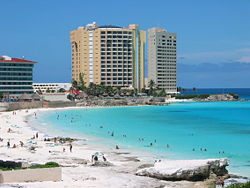
The original master plan was repeatedly modified and, on the mainland, often ignored. Despite initial skepticism that forced the Mexican government to finance the first eight hotels, Cancún soon attracted investors from all over the world. Accurate statistics on Hotel Zone property ownership are not easy to find. Anywhere from 50% to 70% of the Hotel Zone properties are owned by Mexicans, depending on how the figures are calculated -- number of rooms, land area, and type of property. The Hotel Zone includes hotels (unofficially estimated at 50% foreign ownership), time shares (ratio unknown but probably predominantly foreign), condominiums (much more likely to be Mexican owned), and commercial buildings and private residences (almost exclusively Mexican). Another complicating factor is split ownership of land and improvements, as the owner of a building may not own the land on which it is located. Mexican ownership is close to 100% for the mainland. Hotel operating companies are international companies that supply administration and marketing services and these companies do not usually own the hotels themselves. Even outlets of restaurant chains such as McDonald's and Domino's Pizza are Mexican-owned.[1]
Tourism

There are about 150 hotels in Cancún with more than 24,000 rooms and 380 restaurants. Four million visitors arrive each year in an average of 190 flights daily. The Hotel Zone of Cancun is shaped like a 7 with bridges on each end connecting to the mainland. Hotels on the vertical or long side of the 7 tend to have rougher beaches and beach erosion can be a problem. Resorts on the horizontal or short end of the seven tend to have more gentle surf because the waves here are blocked by the island of Isla Mujeres which lies just off shore. The Hotel Zone offers a broad range of accommodations, ranging from relatively inexpensive motel-style facilities in the older section closest to the mainland, to high-priced luxury hotels in the later sections.
Many of the hotels are time-share condominiums with kitchen facilities. Some are all inclusive hotels which offer unlimited breakfast, lunch, dinner and snacks, beverages, both alcoholic and non-alcoholic, hotel activities, entertainment, non-motorized water sports, and 40% discounts on tours to the Mayan ruins. Tips and taxes are included in the price of the hotel rooms. There are also upscale private residences and lavish condominiums for rent that cater to the rich. Restaurants, bars and shops in the hotel zone tend to be rather expensive compared with the downtown area and other Mexican resorts. Travelers will find many well-known theme restaurants and clubs here. Although the Hotel Zone is frequently described as "posh" or "exclusive" the main Cancún tourism market is middle- and upper-middle-class, according to government statistics, which also report that more than 37% of Cancún visitors are Mexican.
On the opposite side of the island from the Caribbean Sea is the Nichupté Lagoon, which is used for boating excursions and jet-ski jungle tours.
Downtown is home to less expensive places to shop, including many supermarkets such as three Wal-Marts, two Comercial Mexicanas, at least seven large Chedraui's and three Sorianas, not to mention several flea markets like The Zocalo in the heart of the Hotel Zone. Market 28, Downtown, is a well-known shopping place both for locals and visitors. Downtown also hosts a number of American franchises such as Office Depot, Office Max, the aforementioned Wal-Marts, Sears, Sam's Club, Costco, Blockbuster, and a number of Starbucks (also located at the Hotel Zone) just to name a few. It also contains countless smaller hotels that can be had at a fraction of the price for similar accommodations in the Hotel Zone. International brands in Downtown area include Radisson Hacienda Cancún, Best Western Plaza Caribe, Oasis America.
Cancun is also the gateway to the Riviera Maya, another tourist pole in the area, where people go attracted by the numerous archaelogical sites, as Coba and Tulum, the many cenotes, the ecological parks as Xcaret and charming towns as Playa del Carmen.
Weather

The temperature of the city is warm and tropical, moderated by the marine breezes created by onshore trade-winds, which circulates through its avenues. Depending on the season, maximum temperatures range from 26 °C (78.8 °F) in January to 32 °C (90 °F) in June and between 18 °C (64.4 °F) and 25 °C (77 °F) at night. Temperature extremes have ranged between a maximum of 39.5 °C (103.2 °F) and a minimum of 9.5 °C (49.2 °F) 5 km (3.1 mi) inland at the Airport at the south end of the city. More temperate conditions occur from November to February and it is hottest from April to September, due to proximity to the Caribbean and Gulf humidity is high all-year around (averages close to 70% on rain free days).
All hotel rooms in the Hotel Zone and many on the mainland are air conditioned. Weather is highly variable. During winter, occasional nortes (Fast-moving cold front passing southward from the North American continent) drop temperatures sharply to below 20 °C (68 °F) and sometimes even cooler, surprising even tourists from northern climates, fortunately such periods do not last long before conditions improve. In the course of a single day, the weather can turn from bright sunshine to dark and stormy and back again. It's not uncommon to look out one's window and see sunshine, while rain is falling on the opposite side. Sun showers and rainbows are frequent throughout the year, but especially during the summer rainy season. Many weather sites on the Internet will routinely report rain every day and this causes undue alarm among future vacationers. Cancún is on the ocean, the high level of humidity in the air and therefore there is always the chance for rain, all-day rain is infrequent and usually associated with tropical storm activity.
The tropical storm season lasts from May to December, the rainy season extends into January with peak precipitation in September. February to early May tend to be drier with only occasional scattered showers. Although large hurricanes are rare, they have struck near to Cancun in recent years, Hurricane Wilma in 2005 being the largest and almost twenty years ago, Hurricane Gilbert made a devastating direct hit on Cancún in September 1988.
Mayan Archaeological Sites
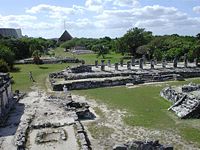
There are some (relatively) small Mayan vestiges of the pre-Columbian Maya civilization in Cancún. Ruinas El Rey are located in the Hotel Zone. El Meco, a more substantial site, is found on the mainland just outside the city limits on the road to Punta Sam.
Very close, at the Mayan Riviera and the Grand Costa Maya, there are impressive sites such as Cobá and Muyil (Riviera) the small Polé (now Xcaret), and Kohunlich, Kinichná, Dzibanché, Oxtankah, Tulum, and Chacchoben, in the south of the state.
In the neighbor state of Yucatán is located impressive Chichen Itza, The UNESCO World Heritage granted this Mayan archaeological zone World Heritage Site status in 1988 and it was recently voted through Internet as one of the New Seven Wonders of the World.
Colleges and universities
Although Cancún is better known as a travel and tourism destination, in recent years some colleges and universities have been offering higher educations to both Mexican and foreign students.
The first higher education institution established in the area was the Instituto Tecnológico de Cancún. Some other followed such as Universidad La Salle Cancún, Universidad Anahuac Cancún, Universidad Tecnológica de Cancún, Universidad del Caribe, and more recently the Universidad Interamericana para el Desarrollo and the Tec Milenium.
Hurricane Impact
Cancún is located in one of the main Caribbean hurricane impact areas, but since it was founded it has received direct hits from only two major hurricanes, Gilbert (1988) and Wilma (2005). In both cases, federal, state and municipal authorities were well-prepared to deal with most of the effects on tourists and local residents. After Wilma, emergency plans were modified to rectify areas of weak performance. Among other improvements, a new hurricane-proof traffic light system was installed throughout the city and Hotel Zone. To avoid having tourists wind up in uncomfortable situations in public shelters, authorities asked tourism operators to suspend sending tourists to Cancun when Hurricane Dean approached, and encouraged airlines to send empty planes, which were then used to evacuate tourists. Most recently, remnants from Tropical Storm Olga caused some localized flooding on December 14, 2007.
Hurricane Wilma

On October 21, 2005, Hurricane Wilma made landfall on Mexico's Yucatán Peninsula as a powerful Category 4 hurricane, with strong winds in excess of 150 mph (240 km/h). The hurricane's eye first passed over the island of Cozumel, and then made an official landfall near Playa del Carmen in the state of Quintana Roo at around midnight on October 22 EDT with winds near 140 mph (230 km/h). Portions of the island of Cozumel experienced the calm eye of Wilma for several hours with some blue skies and sunshine visible at times. The eye slowly drifted northward, with the center passing just to the west of Cancún, Quintana Roo. Some portions of the Yucatán Peninsula experienced hurricane force winds for well over 24 hours. The hurricane began accelerating in the early morning hours of October 23, exiting the northeastern tip of the Yucatán Peninsula and entering the Gulf of Mexico as a Category 2 storm.
Wilma made several landfalls, with the most destructive effects felt in the Yucatán Peninsula, particularly in Cancún. At least three deaths have been reported, numerous people have disappeared, and the insured damage is estimated at between US$5 and US$8 billion. Many of the principal roadways from the Hotel Zone were completely flooded and damaged. Once the storm left the peninsula, some of the beautiful beaches of Cancún had been washed away. Thousands of local and foreign tourists were hosted in improvised refuges. All airport and harbor operations were cancelled between 21-25 October due to the bad weather conditions.
It is estimated that after Wilma left Cancún, the local tourism industry lost over US $15 million daily. Many houses were damaged, and many jobs were lost. However, thanks to the aid and support of local and state governments, the federal government, the Red Cross, and civic associations, reconstruction has been possible. There was an exhaustive campaign by the media that featured public figures, including Mexico's President Vicente Fox, actors and musicians to aid people who suffered.
Recovery
When Hurricane Wilma finally passed, an almost 8-mile (13 km) stretch of Cancun's beach was washed away, exposing a line of jagged rocks. Cancun's recovery from the storm, however, has been noteworthy, so much so that the United Nations World Tourism Organization has declared it a model to emulate in future disasters.
The Mexican government paid US$24-million to the Belgian firm Jan de Nul to vacuum up offshore sand roughly 20 miles (32 km) off the coast of Cancún and pump it back to resort-front beaches. The result of the completed beach restoration is that Cancún's beach front is now roughly twice as wide as it was before the storm (going from roughly 70 feet (21 m) wide to the present-day 140 ft). Beach erosion remains a serious problem despite the restoration. Some stretches have lost approximately 30 feet of sand, and a few very problematic areas are now back to about to a width of 30 feet or less. The new sand is much coarser and somewhat darker than the powdery white original Cancun beaches.
Roughly $2.3-billion in insurance claims were filed in the aftermath of Wilma, but many hotel and resort owners took the opportunity to upgrade the quality of their rebuilt properties and add more condos to the mix of accommodations.
Hurricane Dean
Although Hurricane Dean touched land at Majahual, approximately 190 miles (310 km) south of Cancun, fierce winds at the outside of its impact cone stripped some of the sand off 7.5 miles (12.1 km) of beach from Punta Cancun (Camino Real Hotel) to Punta Nizuc (Club Med), reports Virginia Prospero in Novedades de Quintana Roo. Local resident Anita Brown's photographs of the damage can be seen here and here.
External links
- Cancun travel guide from Wikitravel
- Cancún at the Open Directory Project